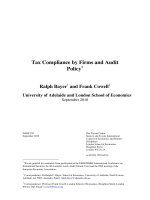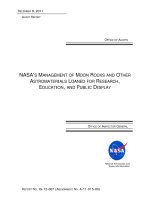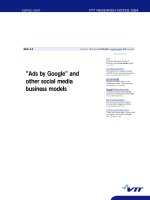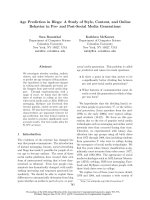VTT RESEARCH NOTES 2384 "Ads by Google" and other social media business models potx
Bạn đang xem bản rút gọn của tài liệu. Xem và tải ngay bản đầy đủ của tài liệu tại đây (1.16 MB, 64 trang )
VTT RESEARCH NOTES 2384 "Ads by Google" and other social media business models
ESPOO 2007 VTT RESEARCH NOTES 2384
Social media is becoming more and more attractive to Web users. However,
the majority of social media services do not have a clear business model.
Typically an innovative idea gives birth to a service, which people can use
free of charge. The most common way to create revenue is via advertise-
ments: Google ads appear in many services. In the long run, however,
social media has to adopt alternative means for making money.
At the moment there are a few alternative business models, of which
four larger themes are reported: Crowd-sourcing, revenue sharing bet-
ween services and users, developing and selling underlying technologies,
and adopting social media tools and approaches for professional use.
Some examples of these approaches already exist.
The report also identifies and defines some core concepts of social
media, as well as investigates various phenomena co-occurring with
social media, namely user activeness, identity, copyrights, mobility, trust,
and side-effects. These phenomena should be kept in mind when desig-
ning and launching social media products and services.
Julkaisu on saatavana Publikationen distribueras av This publication is available from
VTT VTT VTT
PL 1000 PB 1000 P.O. Box 1000
02044 VTT 02044 VTT FI-02044 VTT, Finland
Puh. 020 722 4404 Tel. 020 722 4404 Phone internat. + 358 20 722 4404
Faksi 020 722 4374 Fax 020 722 4374 Fax + 358 20 722 4374
ISBN 978-951-38-6917-5 (nid.) ISBN 978-951-38-6918-2 (URL: />ISSN 1235-0605 (nid.) ISSN 1455-0865 (URL: />"Ads by Google" and
other social media
business models
VTT TIEDOTTEITA – RESEARCH NOTES 2384
“Ads by Google”
and other social media
business models
Petteri Kangas, Santtu Toivonen & Asta Bäck (eds.)
ISBN 978-951-38-6917-5 (nid.)
ISSN 1235-0605 (nid.)
ISBN 978-951-38-6918-2 (URL:
ISSN 1455-0865 (URL:
Copyright © VTT 2007
JULKAISIJA – UTGIVARE – PUBLISHER
VTT, Vuorimiehentie 3, PL 1000, 02044 VTT
puh. vaihde 020 722 111, faksi 020 722 7053
VTT, Bergsmansvägen 3, PB 1000, 02044 VTT
tel. växel 020 722 111, fax 020 722 7053
VTT Technical Research Centre of Finland, Vuorimiehentie 3, P.O.Box 1000, FI-02044 VTT, Finland
phone internat. +358 20 722 111, fax + 358 20 722 7053
Technical editing Maini Manninen
Edita Prima Oy, Helsinki 2007
3
Kangas, Petteri, Toivonen, Santtu & Bäck, Asta (eds.). “Ads by Google” and other social media business
models. Espoo 2007. VTT Tiedotteita – Research Notes 2384. 59 p.
Avainsanat: social media, Web 2.0, Internet, business model
Abstract
Social media is becoming more and more attractive to Web users. However, the
majority of social media services do not have a clear business model. Typically an
innovative idea gives birth to a service, which people can use free of charge. The most
common way to create revenue is via advertisements: Google ads appear in many
services. In the long run, however, social media has to adopt alternative means for
making money.
At the moment there are a few alternative business models, of which four larger themes
are reported: Crowd-sourcing, revenue sharing between services and users, developing
and selling underlying technologies, and adopting social media tools and approaches for
professional use. Some examples of these approaches already exist.
The report also identifies and defines some core concepts of social media, as well as
investigates various phenomena co-occurring with social media, namely user activeness,
identity, copyrights, mobility, trust, and side-effects. These phenomena should be kept
in mind when designing and launching social media products and services.
4
Foreword
In early winter 2006, a decision was made at VTT that social media business
opportunities should be studied and identified. YouTube and MySpace received major
media coverage almost every day. It seemed that enthusiasm about the possibilities of
new technology intensified to a level comparable to the turn of the millennium. When
Google acquired YouTube in October 2006, there was even talk of a “mini-bubble” in
Silicon Valley with reference to the events at the turn of the millennium. However, very
few had any idea of the business models on which the new social media applications
were based. Is “Ads by Google” the only viable method of earning, or could some novel
and different ways of making money be found?
During the work, we identified the business models presently in use and got some hints
about the kinds of workable models that might be introduced in the future. Work with
social media will continue at VTT, and the aim is to utilise the findings from this
publication in the development of new technologies and services.
This publication was compiled in the spirit of social media: The publication was written
in a wiki environment. Only the final version was transferred to a word processor. This
publication was firstly published as closed beta version for a Finnish audience. It was
written in Finnish in order to get better feedback. Based on the comments of the closed
beta version, some modifications were made in this public version, which is written in
English. The changes are mainly in the analysis of the future possibilities.
In addition to the editors, Jukka Kiviniemi, Jukka Hemilä and Matti Penttilä have
contributed to the authoring in the wiki.
Espoo, April 2007
The authors
5
Contents
Abstract 3
Foreword 4
1. Introduction 7
2. Definitions 8
2.1 General concepts 8
2.2 Core concepts 9
2.2.1 Web 2.0 9
2.2.2 Content 11
2.2.3 Communities 12
2.2.4 Social media 12
2.3 Derivatives 13
3. Present business models 15
3.1 Analysed services 16
3.1.1 MySpace 20
3.1.2 YouTube 22
3.1.3 Wikipedia 24
3.2 Identified business models 27
3.2.1 No business model 27
3.2.2 Advertisements 28
3.2.3 Subscription-based services 30
3.2.4 Merchandise 31
3.3 Risk financing 33
4. Specific issues 36
4.1 Activeness 36
4.2 Identity 38
4.3 Copyright 38
4.4 Mobility 40
4.5 Trust 41
4.5.1 Trust in general 41
4.5.2 Trust and social media 41
4.6 Advertising 44
4.6.1 Ads by Google 44
4.6.2 Product placement 45
4.7 Side-effects 46
6
5. New business opportunities 48
5.1 Crowd-sourcing 48
5.2 Revenue share 49
5.3 Underlying technology 52
5.4 Social media in professional use 54
6. Conclusions 56
6.1 Specific issues 57
6.2 New models 57
7
1. Introduction
There are more than 70 million blogs in the world. The online video service YouTube
was sold to the search engine giant Google for more than one billion dollars after one
year of operation. Time Magazine nominated Internet users as Person of the Year.
Social media made a breakthrough during 2006. Is this just another Internet bubble or
can ways of earning money be found behind the services?
The objective of the Resome
1
project is to create a clear idea of how social media is
commercially exploited at present. The project surveys various business models
surrounding social media. The objective is to answer the question: Is advertising, Ads
by Google, the only business model for turning content into money? Our hypothesis is
that there must be other viable business models surrounding social media besides
advertising.
Furthermore, we aim to uncover the opportunities that Finnish industry and the research
world have in the domain of social media. A further objective of the project is to define
a clear and unambiguous glossary of social media terminology.
1
Resome = Revenue from social media.
8
2. Definitions
“Social media, collective intelligence, content, community, sociality ”
This chapter defines the concepts surrounding social media that will be utilised later in
this publication.
2.1 General concepts
Media refers to a means of communication, a carrier of information. Usually we refer to
mass media regardless of whether it actually is the TV, radio, newspapers or
advertisements in the cityscape. The Internet is one of today’s most important media
2
.
Sociality refers to
3
• interaction between individuals
• belonging to a group
• caring for others.
A business model answers the questions: what does an enterprise offer, how and to
whom. A business model is described by at least the following:
• What is the product’s value to the customer?
• Who is the customer?
• Who are partners?
• Which are the enterprise’s areas of core competence?
• What are the costs?
• What is the revenue – that is, how does the product make money?
2
Wikipedia: (12 January 2007)
3
Wikipedia: (12 January 2007)
9
Business based on social media must adhere to the same basic rules applicable to other
fields of business and applications. The starting point is a need and an idea based on it,
which serve as the basis for building a product offering.
In this publication, mobility refers particularly to users who produce and consume
social media contents when mobile. The terminal device used by a mobile user for the
production and consumption of social media is typically (but not necessarily) a mobile
phone or some other compact device with data connections. Mobility enables efficient
recording and real-time distribution of world phenomena. Mobility can also be utilised
when consuming information. For example, by determining the location of the user, a
terminal device could emphasise content produced by people geographically close to the
user or content related to geographically close objects.
2.2 Core concepts
The core concepts surrounding social media – Web 2.0, content and community – are
illustrated in the following picture.
Communities
Content
Web 2.0
Social
media
Communities
Content
Web 2.0
Social
media
Picture 1. The core concepts of social media.
2.2.1 Web 2.0
In this publication, Web 2.0 refers particularly to a set of technologies that enable easy
production and distribution of social media on the Internet. It provides a functional
environment for the realisation of social media together with content produced by users
10
on the one hand and communities on the other, as is evident from the picture of core
concepts. Below are some other characterisations of Web 2.0 from different sources.
Web 2.0 is a name invented by Tim O’Reilly for applications typically exhibiting the
following characteristics
4
:
• The Web as a platform
• Harnessing collective intelligence
• Data is the next “Intel Inside”
• End of the software release cycle, “the perpetual beta”
• Lightweight programming models
• Software above the level of a single device
• Rich user experiences.
According to the same source, the characteristics of a Web 2.0 company include:
• Services, not packaged software, with cost-effective scalability
• Control over unique, hard-to-recreate data sources that get richer as more people
use them
• Trusting users as co-developers
• Harnessing collective intelligence
• Leveraging the long tail through customer self-service
• Software above the level of a single device
• Lightweight user interfaces, development models, and business models
According to Wikipedia, the term Web 2.0 refers to the following
5
:
4
5
Wikipedia: (12 January 2007)
11
• The transition to more functional Web-based applications
• A more social approach to generating and distributing content, characterised by
open communication, decentralisation of authority, as well as freedom to share
and re-use information.
Mobile Web 2.0: This publication utilises the definition in the book Mobile Web 2.0,
according to which the following characteristics make Mobile Web 2.0 special in
relation to Web 2.0
6
:
• Using a mobile device as an information acquisition device
• Based on the Web, but Web protocols are not necessarily used at every stage
(particularly at the customer end)
• The PC is used as a cache and configuration platform for services.
According to the book Mobile Web 2.0, contacts and links are the core of Mobile Web
2.0: “Contact is king”.
2.2.2 Content
Social media is particularly based on user generated content (UGC), which may be:
• new content, such as images, videos, music or text
• modified content, such as compilations, video mixes or mash-up services
• categorised content, such as playlists, reviews or keywords (can also be
classified as metadata).
With regard to content, this publication focuses particularly on user generated content
and pays less attention to content produced by enterprises or public administration. For
example, in the core concepts picture, “content” particularly refers to content produced
(and consumed) by users.
6
Jaokar, A. & Fish, T., Mobile Web 2.0. London, UK: Futuretext.
12
2.2.3 Communities
From the viewpoint of this publication, communities are an essential component of
social media (see Section 2.2, Core concepts). While Web 2.0 provides the
technological facilities for the realisation of social media and individual users provide
the content, communities serve as efficient analysers with regard to finding interesting
material. Communality has of course existed before Web 2.0, the Internet and other
technological innovations but these have enabled new manifestations of communality,
such as communities independent of time and place.
On the Citizens’ forum
7
, the concept of a community is defined as follows: “The word
community is commonly and inaccurately used as a general name for group formations.
The scope of the concept of community may range from mankind to two or three people,
and its area may range from the globe to a family. Most generally the concept of
community refers to a method of human interaction, solidarity, interpersonal
relationships or things common to a certain group of people. Communities can be
categorised by their objectives (such as care communities) and by the nature of
interaction (such as ideological communities).”
According to Professor Peter Lyman of UC Berkeley, communality and social media
can also be understood through the gift analogy
8
: “In classic social theory, a gift is
something given to establish or renew a social relationship. Thus the Web might well be
described as a gift exchange economy, one within which millions of authors are giving
away intellectual property for the sake of developing a sense of community. In giving
away intellectual property, one expects to receive information of equal or greater value
in exchange, or perhaps social status in the community.”
2.2.4 Social media
Social media is built of content, communities and Web 2.0 technologies. Social media
refers to applications that are either completely based on user generated content or in
which user generated content and the actions of users play a substantial role in
increasing the value of the application or service.
Social media can be produced by an existing community, or a community may be
formed of individuals who produce content to the same service. On the other hand, the
7
Citizens’ forum (Kansalaisfoorumi, in Finnish):
8
Peter Lyman,
13
users of social media may include individuals who do not belong to the community and
only utilise social media.
Social media applications are characterised by
9
:
• participation
• openness
• conversation
• community
• connectedness.
Related terms:
User driven applications is (most often) a synonym for social media, clearly raising
the role of users and also the fact that the applications are not related solely to the media
sector. It is essential for social media applications that users have a new role in the
realisation of a service and the creation of added value provided by the service.
Participatory media emphasises the active participation of users
10
.
Social software provides the information technology foundations for social media.
Applications support easy creation and distribution of content and the formation of
communities. Many applications are also developed and maintained by communities
11
.
Social network sites display the (online) identities of people, their mutual relationships
and comments on the identity by the person him/herself or others
12
.
2.3 Derivatives
Swarm intelligence or collective intelligence originally referred to collective behaviour
arising among social insects. Natural examples of systems with swarm intelligence are
ant communities, as well as the behaviour of birds, fish and many mammals in flocks
and herds. Swarm intelligence is a hypothesis stating that even though individual people
9
Spannerworks:
10
Wikipedia:
11
Wikipedia: Social software
12
Zephoria:
14
do not know something in great detail, sufficiently precise knowledge can be obtained
by aggregating the knowledge of many people
13
. The idea is holistic: the whole is more
than the sum of its parts.
In the case of social media, swarm intelligence can be seen as an emergent phenomenon
that increases when social media applications attract more and more users to produce
content and form communities. Swarm intelligence is utilised, for example, by services
that recommend books, records and films on the basis of similar tastes in a large group
of users. This activity is also referred to by the more specific term collaborative
filtering.
Mash-up
14
refers to a service that combines content from two or more separate services.
A mash-up service can present different information in a new way: for example,
bringing services onto a map provides many traditional services with a totally novel
way of processing and presenting information. The number of mash-ups has recently
snowballed. This is attributable to new Web 2.0 technologies such as open interfaces
and the separation of content and appearance.
13
General list of index terms (in Finnish):
14
TKK:
15
3. Present business models
Social media was the talk of the town in late 2006. The success stories of MySpace and
YouTube made the most critical people recall the previous IT bubble. There is a lot of
money around social media. From July 2005 to August 2006, there was about half a
billion euros worth of risk financing around. In the summer of 2006, Google first
bought advertising rights on MySpace for a billion dollars and later in the autumn
acquired YouTube for 1.3 billion euro (see Picture 2).
Picture 2. YouTube’s Chad and Steve laughing on their way to the bank.
15
The report analyses the business models of a couple of dozen services based on social
media. However, regrettably the services often do not have any clear earnings logic. The
objective is only to grow large and powerful, inspired by the success stories. This
chapter first deals with the analysed services, with additional detail on those considered
most significant. After this, we present four identified business models and associate the
analysed services with these business models. Picture 3 provides a general image of the
services and the identified business models.
15
Youtube:
16
Picture 3. Analysed services grouped in a fourfold table by their business models.
3.1 Analysed services
The analysed services are described concisely, explaining what the different services
offer their customers. Why should one start to use a particular service among the
thousands on offer? What is the value of each service to the customer? Three major
services are described in more detail at the end of the chapter: MySpace, YouTube and
Wikipedia.
Flickr: An easy way to publish digital photos online free of charge. The photos can be
sorted by various social media methods: tags, favourites lists, various groups, as well as
Geotagging
16
.
iStockPhoto: An extensive photo agency for an ordinary user looking for picture
material to use in his/her own works. An economical way for photographers to cash in
on their pictures. Thousands of photographers around the world put their material on
sale on iStockPhoto
17
.
Last.fm: An individualised Internet broadcaster that plays music to the listener’s taste
and offers new interesting pieces. Playlists for people with similar musical tastes are
created on the basis of user preferences. Users can sort music using tags. An alternative
16
Flickr:
17
iStockPhoto:
17
to powerplay stations. Free music
18
. The most recent version of Last.fm provides users
with the possibility to share information regarding the currently playing music with
one’s Skype community – a good example of a social media mash-up.
ODEO: Provides tools with which users can create and publish their own podcasts.
There is no need for special software or a personal Web server for storing the podcasts.
Podcasts can be published as feeds, various lists can be created, and they can be sorted
using tags
19
.
Google Video: An opportunity to download and share videos independent of time and
place. The service has a ready-made billing and distribution system for videos. The
service can be used by media companies and home video enthusiasts alike. Users upload
their own videos to the service. It is easy to share videos and search for them using a
variety of search words. Users need not worry about expensive communications costs
20
.
Blogger: A free blog for anyone. The service aims for ease of use. Blogs constitute a
social media network in which the most popular topics spread rapidly
21
.
Wetpaint: An easy-to-use publishing system for various groups. Users jointly create
content for a wiki (cf. Wikipedia). The content develops and improves as a result of
shared work. Wiki provides a holistic view of the matter
22
.
Writely: A free word processor that can be used anywhere with a Web browser. The
service also has an archive for user documents. Excellent groupwork features and
support for publishing text in various formats (such as .doc, .pdf and blogs). A group of
users may jointly edit a document. Documents are transferred from the user’s computer
to the network and can be easily published as a blog, for example. A tool supporting
social media
23
.
Habbo Hotel: A virtual comic-book/game-like community on the Internet. Users build
content for the service by decorating their rooms, creating different kinds of
communities and living in a virtual world
24
.
Second Life: A virtual world created by its users. Users create content in the world and
hold the copyrights. Content can be sold and bought inside and outside the game.
18
Last.fm:
19
ODEO:
20
Google Video:
21
Blogger:
22
Wetpaint:
23
Writely:
24
Habbo Hotel:
18
A functional economic system in which money can be exchanged from euros into play
money
25
.
World of Warcraft: The most popular online role-playing game in the world. Users
create content for the game all of the time: establish guilds, start wars and create
utilities. The manufacturer supports all of this. Additional content creates a snowball
effect. Furthermore, user generated content has a secondary market in online auctions. It
is possible to exchange virtual money into real money
26
. However, the most popular
online auction site eBay announced in January 2007 that it will ban the sales of virtual
money on the site.
Technorati: The world’s largest blog search engine. Technorati currently analyses 55
million blogs. The search engine analyses the popularity of the blogs and the most
important topics appearing in them. An analysis of users’ blogs and links to other blogs
can be used to assess the popularity and quality of blogs and the hottest topics in the
blog world. Furthermore, information of a similar type can be linked together.
FeedBurner: A centralised service for feed providers. A single service that generates
standard feeds and provides tools and statistical methods facilitating use. A service built
on social media that makes it easier to distribute information. Supports different types of
source material and many of the most popular services such as Technorati and
del.icio.us
27
.
Newswine: World news ranked by users. Users decide on the significance of news. The
service contains news written by professionals as well as the users themselves. Users
can send important news to the service when browsing the Web. News can also be
commented on
28
.
del.icio.us: Users can quickly find high-quality sorted Web pages in this service.
Sorting is done by other users on a voluntary basis. Users categorise Web pages they
have visited using tags
29
.
LinkedIn: An efficient tool for expanding one’s network of contacts. Users of the
service enter their own network into the service and invite new members to join the
25
Second Life:
26
World of Warcraft:
27
FeedBurner:
28
Newswine:
29
del.icio.us:
19
network. The service allows users to gain new contacts in the network. The entire
service is based on user generated content
30
.
Koulukaverit.com: The service allows users to find out the whereabouts of their old
school friends. The service also provides contact information. The content is created by
users who have specified the schools and classes that they attended
31
.
HousingMaps: Provides a view to craigslist classified housing ads on the Google map.
The service is similar to that of major housing agencies. It provides a new view to
classified ads, geographically placed
32
.
threadless: Sales of T-shirts designed by users. If a user designs the week’s best print
for a T-shirt and the image is printed on a shirt, the shirts are sold on the site. Users also
vote on the winner
33
.
Yahoo Answers: Answers to questions occupying your mind. The questions are
answered by other users. Giving good answers will improve a user’s status within the
service and the community. This is the same phenomenon seen in forums and
newsgroups: some answers are considered “good”
34
.
Rollyo: The service provides the opportunity to create a tightly focused personal search
on a handful of Web addresses only. This provides more precise search results with no
unnecessary hits. Searches created by users are available to other users. Searches are
sorted using tags
35
.
Planzo: An opportunity to store your calendar data on the Internet. It is easy to share
calendar data, and you can display your calendar in various services such as blogs. The
calendars of users and groups are a part of social media
36
.
eSnips: The user can store images, videos and music in the same service. Content stored
in the service can be grouped by links and tags. Other users can comment on the
content
37
.
Big Brother: Viewers of the TV show can participate by voting for the exclusion of
competitors, making up tasks for the competitors and speculating on the progress of the
30
LinkedIn:
31
Koulukaverit:
32
HousingMaps:
33
Threadless:
34
Yahoo Answers:
35
Rollyo:
36
Planzo:
37
esnips:
20
show in discussion forums. Fans of the show form an online community that actively
follows the competition and tries to influence the success of their own favourite. An
active community increases interest towards the product
38
.
The next three services follow the social media ideology even if they are not actually
social media.
Zune: Users get rights to all songs in the Zune service (of which there are millions) for
a monthly fee. You do not need to own the songs. Users can wirelessly distribute their
favourite songs to the devices of other Zune users
39
.
Lulu: An online bookshop for an author’s self-published work. The service is an easy
and inexpensive way to make your text into a book and sell it. No minimum print runs,
the books are printed on demand. Lulu gives a substantially larger proportion of book
revenue to the author compared to traditional publishers. A community of self-
publishing authors
40
.
FON: An inexpensive wireless Internet connection available around the world. The
FON network is built by members of the community by sharing their connection with
other users either free of charge or against a small payment. If a user shares his/her own
connection free of charge, he/she is allowed to use other connections free of charge
41
.
The following is a slightly more detailed analysis of MySpace, YouTube and
Wikipedia.
3.1.1 MySpace
Background
MySpace was established in its present form in July 2003. To our knowledge the
number of user profiles created so far is at least 100 million. MySpace is particularly
popular among 14- to 24-year-olds. According to Alexa statistics
42
, the MySpace site
was ranked third in popularity in the US and sixth in the world in September 2006.
However, the number of MySpace users has not increased significantly during 2006.
38
Big Brother:
39
Zune:
40
Lulu:
41
FON:
42
Alexa:
&range=2y&size=large&y=r&url=myspace.com
21
How and why is it used?
The core of MySpace constitutes user profiles and personal Web pages created around
them. On these pages the user can tell about him/herself (picture, basic information,
types of people he/she would like to meet, hobbies and interests such as music, film,
books). MySpace has a search function for finding interesting people and an internal
email system for communication between users. The users of the site typically comment
on each other and send messages to each other.
MySpace is not the only such networking site, not even the first one. According to
Danah Boyd
43
, the popularity of MySpace is attributable to the following reasons:
• The target group, 14- to 24-year-olds, have more reason to create a public profile
and seek visibility than older people, for example.
• MySpace’s communication features suit the teenage modes of communication
well: immediate communication occurs over IM and MySpace complements this
as an asynchronous communications channel (unlike adults, youth do not use
email).
• MySpace has become a part of everyday activities for many: when you are at the
computer, MySpace is one of the sites open in the background.
• Youth need their own public space, and MySpace has provided such a space.
In addition to the profiles of individual users, MySpace contains clearly commercial
profiles: bands, singers and film stars have their own MySpace profile pages to which
other users can link theirs. This can be seen as a way of demonstrating one’s “fandom”.
TV and film characters and some products also have pages on the site: for example,
Toyota Yaris had some 75,000 “friends” and Honda Element had some 43,000 “friends”
at the beginning of October 2006. The US Army created its own profile page on
MySpace but removed it later as the environment did not ultimately seem to fit its
image
44
. MySpace also contains classified ads: with regard to employment ads,
MySpace is in co-operation with a company called Simply Hired
45
.
43
Danah Boyd:
44
The Wall Street Journal: />O4ZzrfhaMSxyhFoeMI1vn4UUfkc_20060905.html?mod=tff_main_tff_top
45
Simply Hired:
22
Additional products around MySpace
• MySpace Magazine is being planned
46
.
• A MySpace TV show on which users meet each other in the real world.
• Video and other editing tools for easily editing media material for presentation
in the MySpace environment.
• Widgets are available from Widgetbox
47
, for example; these can of course also
be placed on other sites besides MySpace. (The role of WidgetBox is to act as a
market and management site for widgets that ordinary users can attach to their
pages.)
Problems
MySpace has attracted a lot of negative attention lately. There are problems on two
fronts in particular. Real-world negative phenomena such as bullying or isolation arise
among users, and above all, paedophiles use MySpace as a channel for finding contacts
with young people. As a result, the US enacted the Deleting Online Predators Act
(DOPA)
48
in July 2006, according to which computer connections to sites on which
adults may seek sexual contact with minors are not allowed from institutions receiving
public subsidies, such as schools.
In late autumn 2006, several articles were published on the Web revealing that interest
in MySpace has declined and many users have deleted their MySpace user account
49
.
As a counterforce to extensive open communities, other communities have emerged in
which people who already know each other can communicate, and the public visibility
of one’s profile can be restricted.
3.1.2 YouTube
Background
YouTube was established in February 2005. It is currently ranked fifth in the popularity
of Web sites around the world
50
. The increase in popularity has been unparalleled
51
.
46
Myspace Magazine:
47
Widgetbox:
48
Technology review:
specialsections&sc=social&pg=1
49
The Washington Post:
AR2006102800803.html
23
The company was established by three former PayPal employees (Hurley, Chen and
Karim) once eBay had acquired PayPal (Karim left the company to engage in academic
studies). The company was financed by Sequoia Capital, a major California-based risk
financier, which did not take any other financiers along. Google acquired YouTube on 9
October 2006. The sales price was agreed at 1.3 billion euro payable in Google stock.
Sequoia Capital’s share of the amount is expected to be 30%, which means that the
value of Sequoia’s 10 million euro investment increased to approximately 400 million
euro.
Operating model
YouTube is a free distribution channel for videos. Users upload their videos to the
service. They form and are formed into various communities, groups and Top 10 lists.
Users can post reviews and comments on the videos, thus producing feedback and other
metadata that facilitates the search for good material.
Anyone can upload video material to the YouTube Web pages. Videos are presented
using Adobe Flash technology, and every video can be embedded into any Web page.
This feature made YouTube familiar with the users of various social networking sites
(such as MySpace). Easy integration with existing sites and networks made it possible
for the company to become recognised quickly.
YouTube has adopted a simple approach to the copyrights and licensing of content. The
terms and conditions of use provide only one option – that is, content must be freely
available for use in YouTube or any potential successors. The same rights are also
granted to the other users of the service. The right of use ceases if the material is
removed from YouTube (“to use, reproduce, distribute, prepare derivative works of,
display, and perform including without limitation for promoting and redistributing part
or all of the YouTube website (and derivative works thereof) in any media formats and
through any media channels
52
”).
YouTube is criticised for copyright infringement. YouTube bases its operations on the
US “Digital Millennium Copyright Act”, which does not require advance inspection of
materials; it is sufficient that illegal material is removed from the service when found.
The DMCA was born in the 1990s when Hollywood demanded that Internet operators
be held liable for forwarding illegal material but Bell lobbied for an act according to
50
Alexa: (26 January 2007)
51
Alexa:
nytimes.com&range=2y&size=large&y=r&url=youtube.com (26.1.2007)
52
Youtube:









